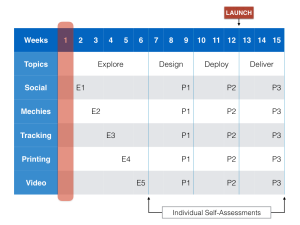 The students were introduced to the project idea on the first day of class, and they were immediately taken with the idea of doing something that had not yet been done before at FSU. We spent a lot of time during that first week talking about what it meant to be innovative and to work with emerging technologies, and we carefully discussed all the things we were going to have to accomplish in a short period of time (15 weeks) if we were going to succeed with this project.
The students were introduced to the project idea on the first day of class, and they were immediately taken with the idea of doing something that had not yet been done before at FSU. We spent a lot of time during that first week talking about what it meant to be innovative and to work with emerging technologies, and we carefully discussed all the things we were going to have to accomplish in a short period of time (15 weeks) if we were going to succeed with this project.
We discussed the plan for the semester in detail (see image). We had only 15 weeks to accomplish our tasks (including this introductory week). We therefore divided the class into four different phases: Explore, Design, Deploy, and Deliver. The first phase, Explore, would last for five weeks (Weeks 2-6), and provide an opportunity for each student (working together in small groups, randomly assigned each week) to explore the requirements for successfully launching the torches into space in each of five different topic areas: Social (i.e., public outreach including websites, blogs, and social media), Mechies (designing and managing the payload, balloon, parachute, helium), Tracking (GPS units for tracking and finding the payload after launch), Printing (3D printing the FSU Torches and anything else needed for the project), and Video (managing the GoPro cameras and deciding what type of video to create). Each group would keep detailed notes about what they learned, handing in their Explore Notes (E1, E2, E3, E4, and E5) at the end of each week.
After exploring each topic in detail, the students would be divided into teams based on their interests, and then spend three weeks (Weeks 7-9) designing the project — coming up with the plans for everything we would need to Launch the Torch into the stratosphere. The goal here was to have everything planned out by the time the students left for Spring Break (which occurred between weeks 9 and 10 of the semester). Each group would hand in a Progress Report (P1) at the end of this phase.
After Spring Break, the students would then spend three weeks (Weeks 10-12) deploying their ideas — including building the payload, testing the equipment, and finally launching the torch at the end of Week 12. We tentatively planned for Saturday, April 2 — weather permitting — for our launch. This would give us all day to prepare the balloon, track the payload, and recover our cameras. Each group would hand in a Progress Report (P2) at the end of this phase.
Finally, after a successful launch, we would then spend the final three weeks of the semester (Weeks 13-15) delivering our final project, including creating and sharing the video of the FSU Torches floating in space. Each group would hand in a Progress Report (P3) at the end of this phase.
The students would each also submit an individual self-assessment detailing what they were learning from the course at the end of Week 6 (documenting lessons learned from the Explore phase), and the end of Week 15 (detailing what they had learned from the class overall).